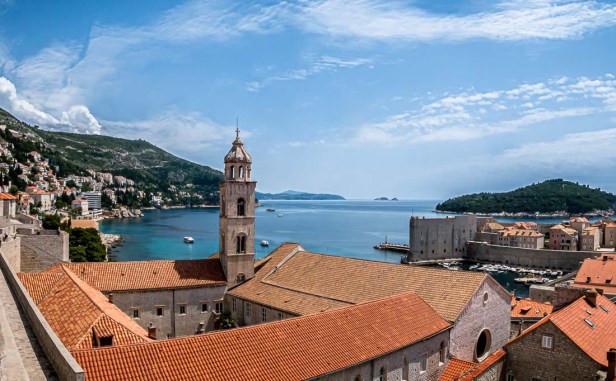
I’m at home in Vancouver now. On this cool summer day I can hear the traffic swooshing past outside the open windows, back and forth as soothing as waves. On the other side, next to me on the couch, I can hear the scratchy sound coming from Don’s earbuds as he watches something on Youtube. If I really concentrate I could probably make out the words. But I don’t, because if I really concentrate I am back in our Airbnb in Dubrovnik on the same kind of cool cloudy day.
5-10 May 2022. The apartment is nice, nothing fancy but clean and comfortable and has all we need. There’s a long balcony. There’s no furniture on it so I take a couple of cushions out with me, one for my butt and one for my back, and leaning back against the wall I take in the view as I drink my morning coffee.
The view is small-town semi-rural with little garden plots close by and in the distance a new housing development. It’s pretty enough to be enjoyable, and bird song fills the air; high pitched chirping and tweeting, and the endless coo-coo of pigeons. This is what I focus on. It’s a soundscape that soothes me. In the distance there’s traffic noise, but the birds are closer and more insistent. They are so busy with their birdy lives; their song has meaning and importance. They are happy. So am I. Despite the difficulties of this trip, moments like this are frequent and nourishing.
We are about a twenty minute walk from the world-famous walled Old Town of Dubrovnik
and I never learn the way there or back, despite covering the distance more than twelve times, since it seems we take a different route every time, involving main roads, many stairs, and back alleys with crumbling stone walls oozing history. And it doesn’t help that we sometimes get lost because Google maps is unreliable, and the signal keeps dropping out and everything swings wildly around until we find the way again.
Don and S and L all talk about the beautiful aroma of mock orange throughout the town. With my limited sense of smell I miss it. There are many real orange trees, their branches weighed down with oranges, and another tree in abundance throughout the town bright with springtime white flowers. Irises are blooming, and there’s a vine that I don’t recognise draping across walls and covered in vivid yellow flowers. Tall thin cedar trees dominate the landscape, reminding me of Tuscany.
As we get close the fortifications tower above us, almost menacing, certainly undeniable.

Eventually we are on the final descent to the Old Town, and see ahead of us the ancient walls that make it such a compelling destination.
I didn’t really know what to expect. I’d seen pictures of course, but it’s never ever the same as being there, actually being in a place you’ve only read about and viewed through someone else’s eyes. The reality is so much more powerful.
We do an early morning history walking tour, starting here: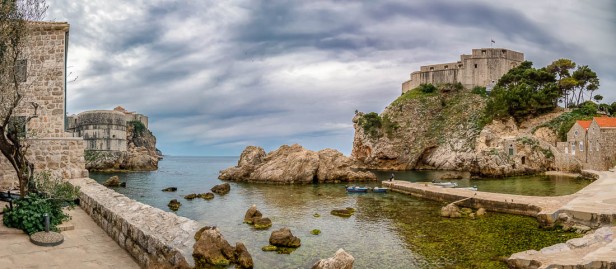
with a guide who clearly loves her country and knows it well. That’s when Croatia comes alive for me; that’s when it becomes about the people, the complex history, the armies, the wars, the thousands upon thousands of ordinary lives lived in this story-book place that’s been inhabited for centuries. That’s when it begins to be more than pictures.
Between rugged limestone mountains and the shimmering Adriatic Sea Dubrovnik cascades down to the water. The Old Town hugs the shore surrounded by protective walls, ancient walls that are the defining feature of the city, built between the 11th and 17th centuries onto the same rugged limestone rocks.
It was a protectorate of the Byzantine Empire, and then a part of the Republic of Venice, but for five hundred years from the 14th to the 19th century Dubrovnik, as the sophisticated Republic of Ragusa, ruled itself as a free state, and rivalled Venice as a trading port. It is known, justifiably, as one of the world’s finest and most perfectly preserved Medieval cities.
We don’t start with the walking atop the walls, but with meandering through the town, most times entering by the formidable Pile Gate. Unchanged for centuries, history seems to rise up like a wraith from the marbled pavement of the grand squares,
from the steep cobbled streets and stairs, and from the ancient stone houses.
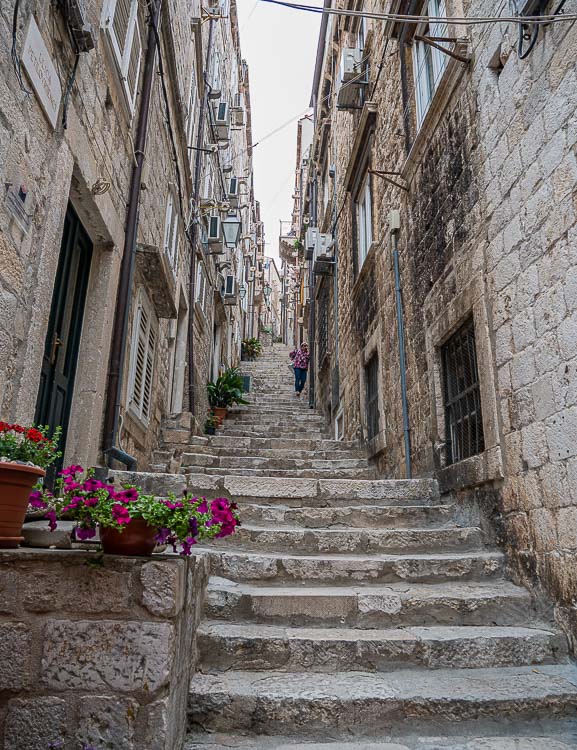
You know people must actually live here by the air conditioners protruding from the walls and the laundry fluttering high above, children playing ball on the cobblestones, and in some of the more hidden lanes small secret gardens behind tall metal gates, but it doesn’t really sink in. Mostly it feels like we are visitors on a movie set.
As we walk through the town, on several different occasions since all our day trips seem to begin and end in the Old Town harbour,
we pass Renaissance cathedrals and fountains, Baroque churches and monasteries, the Gothic-Renaissance Rector’s Palace, now a museum,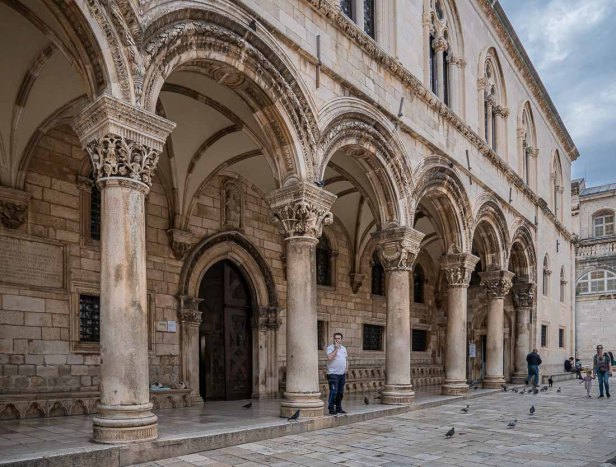
a Franciscan Monk feeding the pigeons purely for his own pleasure, and to the delight of the tourists,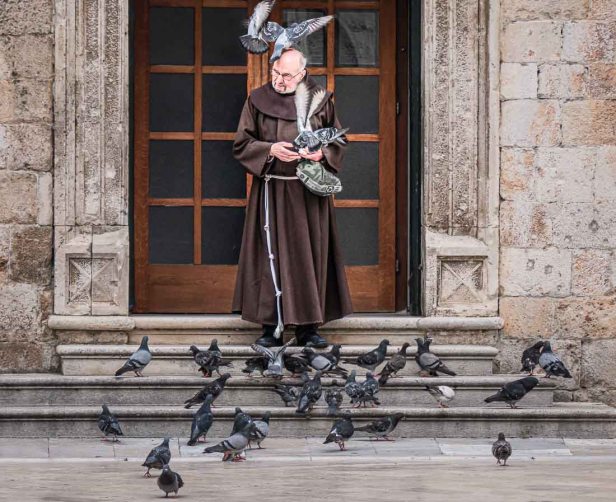
serious medieval sculptures of serious people that strike our modern eyes as delightfully whimsical,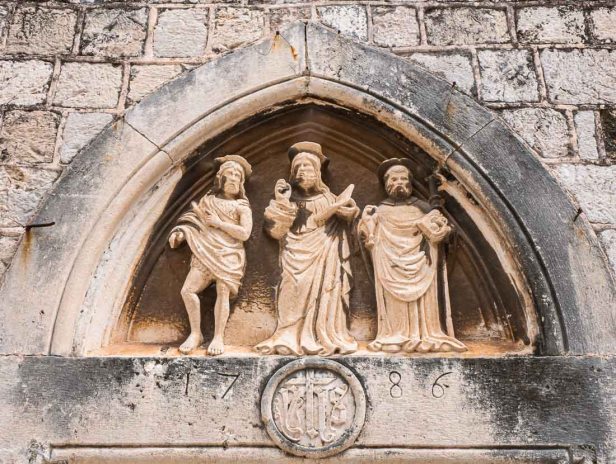
and the Saturday market.
And, of course, the ubiquitous sidewalk restaurants catering to the millions of tourists that flock to this city within a city every year. I’m so glad we’re here during shoulder season and not the height of summer. It’s busy but not impossible.
We go to the Buza Bar.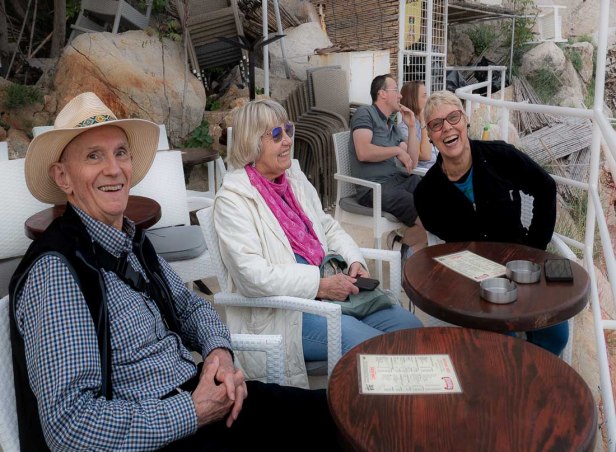
Looking down you can see its precarious perch on the rocks outside the fortifications.
You get to it through a hole in the wall, literally, the high solid impenetrable wall behind you, the shining Adriatic Sea spread out before you.
Someone had the inspired idea to make flat surfaces with concrete and build a bar there. We are enchanted. And thoroughly entertained by the golden light, the flotilla of kayaks,
and by the five young women having pizza and beer on the ledge below us, and then hurling themselves into the freezing water. Well they’re young and perhaps a little drunk. I can feel their joy and freedom.
After a somewhat disappointing meal, we walk out of the Old Town along the main street, known as the Stradun.
On another day we walk along the top of the walls and look down on the Stradun from above.
The fortress-like walls arising directly from the water, coupled with skilled diplomacy, allowed the Republic of Ragusa to remain free and independent for five hundred years. The walls have never been breached, though like most places in Europe the city has changed hands many times. Croatia finally gained independence in 1991 after the break up of Yugoslavia. Then in that same year the city was besieged for seven months by the Yugoslav People’s Army. Once again the attacking force could not breach the city walls, and finally in January 1992 Croatia was internationally recognized. All damage from rocket fire during the siege was meticulously restored. Here you can see the difference between the bright orange roof tiles of the restoration and the ancient roof tiles, the rebuilt walls and the ancient walls.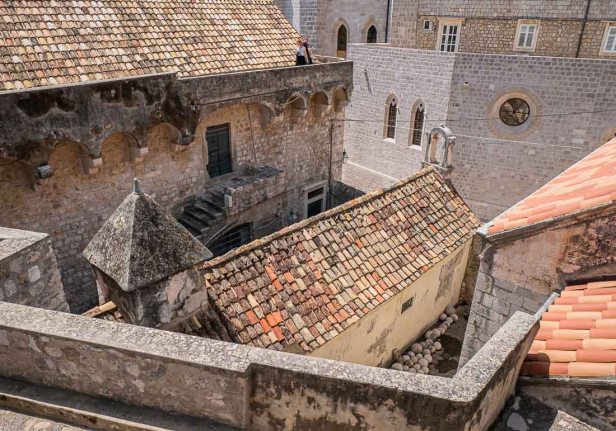
It’s a blue-sky sunny day, then cloudy, then sunny again as we walk the walls – two kilometres (6360 ft) and over 1000 steps. The reward is some of the best views of the town,
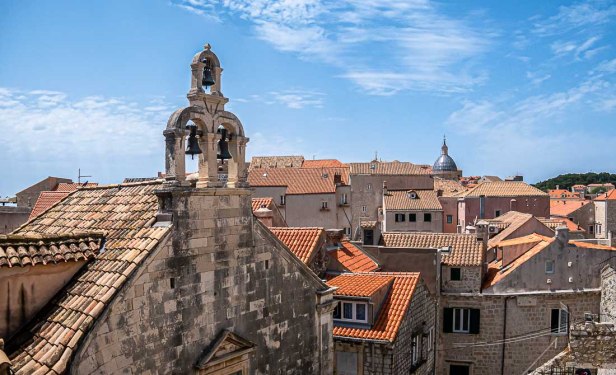
and the water.


The walls and forts are undoubtedly magnificent,

and walking along the top gives us a better understanding of them; how they hug the small safe harbour,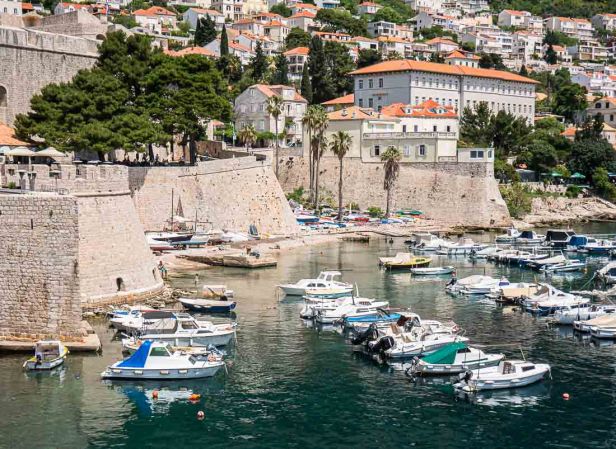
and how in places they are narrow so there’s room only for single file, and in places wide like a highway, wide enough to set up a cafe.

It also gives us a glimpse into ordinary life within the walls, allowing us a kind of intimacy that we would not otherwise get: houses standing among rubble left from the 1667 earthquake,
a curtained window at eye level,
laundry hung to dry – jeans and t-shirts and children’s clothes,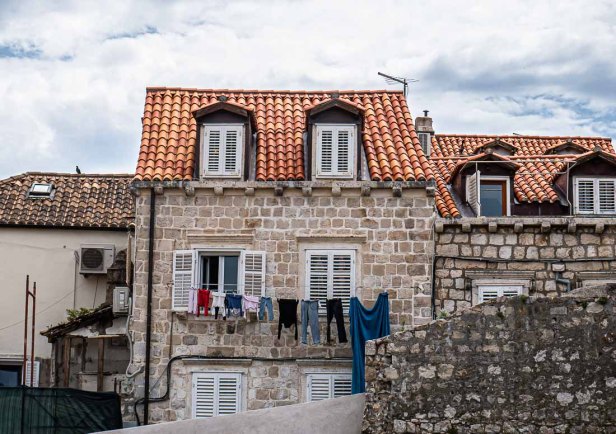
and surprising gardens; so completely unexpected.



I look curiously down on the gardens of those living closest to the walls. They must know that they live in a fish bowl, for better or worse. The reality that people actually live here finally hits me, finally sinks in. It seems more like a stage set, a museum, than a town where ordinary people live ordinary lives, tending to children, jobs, finances, and the mundane activities of life. How incredible it must be to live in such a place, a place that has been here for a thousand years. I realize that for the people who live here it’s normal but to me it seems surreal. That people actually live in such places always surprises me. I experience this same feeling, of things being somehow out of whack, every time I go to Europe, as if there’s been some kind of time warp. To paraphrase Leonard Cohen, there’s a crack in the fabric of time where the light gets in. I feel it throughout Croatia, but it seems especially strong in Dubrovnik, this light, this ineffable luminance that seems to come from still-inhabited ancient places. That such a place exists feels like a miracle, a serendipitous bleed-through from another time, as if it’s not quite real. It fills me with joy and wonder.
Lord Byron, on his Grand Tour was said to have called Dubrovnik ‘the Pearl of the Adriatic’. It’s hard to disagree. It’s not just the town, or the age of it, or the walls and fortifications, or the design of the town with its snug harbour, or even its stunning setting on the infinite blue of the Adriatic. It’s that Dubrovnik is one of those places where the whole is so much more than the sum of its parts, and all of it together becomes a brilliant shining jewel. I feel about Dubrovnik the same way I feel about Venice – both bewildered and delighted that such a place actually exists.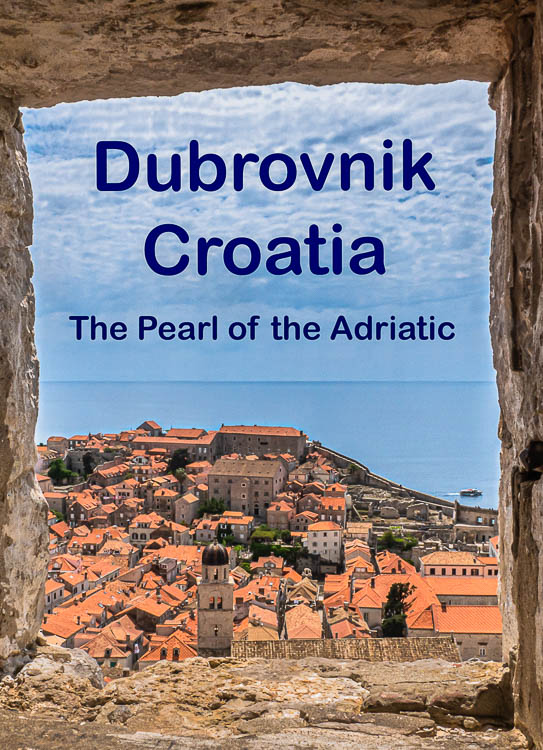
All words and images by Alison Louise Armstrong unless otherwise noted
© Alison Louise Armstrong and Adventures in Wonderland – a pilgrimage of the heart, 2010-2022.

Oh my! Once again you have awakened me to a place I have been with such admiration. We were there for just one day on a cruise. I was amazed then but now I am REALLY amazed. Thank you!
LikeLiked by 1 person
Thanks so much Marla! Isn’t it a spectacular place. I was completely blown away. Glad you enjoyed the post 💕
Alison
LikeLike
I’ve been wanting to visit Dubrovnik for ages. Your photos really catch the eye – the monk with pigeons is my favourite.
LikeLiked by 1 person
Thanks TSMS. I hope you get there on day. It’s really special.
I loved watching that monk – he was enjoying himself so much.
Alison
LikeLiked by 1 person
As always you manage to catch the essence of the place. The realization that people actually live in places like this always catches me off guard.
LikeLiked by 1 person
Beautiful images and words.
LikeLiked by 1 person
Thanks Kay. I’m glad you enjoyed it.
Alison xo
LikeLike
Thanks so much Darlene. That people live in places like this always catches *me* off guard too. It seems somehow surreal. In my mind Dubrovnik somehow has this golden glow over it.
Alison
LikeLiked by 1 person
Thank you for taking me to a place I have been so keen to visit.
LikeLiked by 1 person
You’re welcome! I hope you get there. But go in the off/shoulder season. I’ve read there can be human traffic jams on the walls in the summer.
Alison
LikeLike
So, so beautiful, Alison! I will never forget the gleam on those streets. My absolute favourite of your shots is the Stradun in the evening.
LikeLiked by 1 person
Thank you so much Jo. I’m glad you enjoyed it. It’s such a special place I hardly knew how to describe it so that came across.
Alison
LikeLiked by 1 person
That took me back there. Thanks.
We took the ferry to Lopud Island and kayaked around ther for a week. Lovely.
LikeLiked by 1 person
You’re welcome, glad you enjoyed.
Kayaking there must have been wonderful. Such a beautiful part of the world.
Alison
LikeLike
I’ve seen images of Dubrovnik and read blog posts about this city, but I must say your account of this place is among the most evocative I’ve ever come across. I must say I reached a point where I thought Dubrovnik would be way too touristy to enjoy, although I would never say no if the opportunity arises for me to see it in person. However, you gave me a fresh perspective of this Croatian city, one that sparks interest and wanderlust within me. I love your photos — it’s nice that you got periods of sun when you were exploring the old town — and the anecdotes you included in this post. What a special place!
LikeLiked by 1 person
Thank you so much Bama. I’m glad I inspired you. Just don’t go in the summer. We were there early May, but I bet April would be even better. I hope you get there one day. It really is special.
Alison
LikeLiked by 1 person
Ah Alison, I have been wanting to visit Dubrovnik for years and this captivating post simply took my breath away. It’s not just the beautiful photos and snippets of ordinary life in the old town. Your words transported me to the narrow streets and the tops of the old medieval walls – I felt as if I were there walking right alongside you, filled with the same sense of wonder that flows through your recollections from beginning to end.
I am glad to read that all the damage from the seven-month siege in the early 90s has been carefully repaired. Only an army of savages could deliberately bombard such a beautiful town, and a UNESCO World Heritage site, no less! The complete restoration of Dubrovnik gives me hope that historic war-damaged cities in Ukraine will be rebuilt, and perhaps even emerge as tourist destinations some 10 or 15 years from now.
LikeLiked by 1 person
Thanks so much James. Being transported is the best compliment. I *was* filled with wonder – I’m glad that came across. Even now when I think of it I can hardly believe it exists. You must go! Just don’t go in the summer.
I too appreciated the meticulous rebuilding after the wanton and unnecessary destruction. People destroy, but other people care enough to rebuild – it gives me hope. And yes, I have the same hope for Ukraine. I thought of Ukraine a lot while I was in Croatia. They are not so far apart, and from pictures I think their streets are not that different, people living the same kind of lives. May it all be restored one day – lives and buildings both as much as possible.
Alison
LikeLiked by 1 person
You have captured beautiful photos of a vibrant historical city. Dubrovnik is now on my list of places to go!
LikeLiked by 1 person
Thank you so much. Dubrovnik is special that’s for sure. I’m glad I inspired you!
Alison
LikeLike
Enjoyed the historical walk through
LikeLiked by 1 person
Thanks so much Indra.
Alison
LikeLike
It’s funny that the sound of traffic under your window at home is soothing – for me, that type of big city noise is very soothing, too, I guess because I spent my formative early adult years in a big city. I like the comparison to waves. What a wonderful city to spend time in, with all that history, but too bad you couldn’t always rely on google maps! Your description of the general sense of the city, with the trees, flowers, alleys, and amazing history is very evocative. The observation about it all feeling like a movie set in spite of the air conditioners and laundry is interesting! And then, the time warp feeling you get in Europe – it really is a profound difference.
There are almost enough images here for a book, I don’t know where to start. The architecture is wonderful but those girls jumping in, the kayaks, and the laundry, are all wonderful, too. Such an enjoyable post. Now I want to go. 😉 (The super of our mid-sized, old, NYC apartment building was Croatian. He was an easy-going, small man with a very tall wife and several little kids – memorable!).
LikeLiked by 1 person
Thank you so much Lynn. I definitely recommend going to Dubrovnik (but not in the summer!), I think it’s a wonderful place – well I guess you gathered that from my post.
Thanks re the photos. I had fun with such an interesting place, and then of course people everywhere are interesting to photograph.
Dubrovnik did feel like bit like being on a movie set (and of course it’s now famous for being one of the sets for Game of Thrones, which I’ve never watched). The other place where I had the same feeling was Santorini – Disneyland but still really special – will eventually do a post about it.
I’m living in the most urban place I’ve ever lived, right on a fairly busy road and across from a mall. We get noisy trucks from time to time, and sirens too, but mostly it’s the swoosh swoosh back and forth of cars. Not unpleasant at all.
Alison
LikeLiked by 1 person
A wonderful journey taking me back to a city we loved. Your exquisite photos transported me to our own wanderings. Beautiful post.
LikeLiked by 1 person
Thanks so much Sue. I’m glad it brought back some good memories for you. We too loved Dubrovnik.
Alison
LikeLiked by 1 person
Loved this post! The phrase “Republic of Ragusa” rings a distant memory bell (maybe from the book of Venetian history I read a few years ago?) and the walls are as stunning in your pics as any I’ve seen. Dubrovnik is inching its way up my Europe must-see list.
LikeLiked by 1 person
Thank you so much Felicity. 💕 Those walls blew me away. I’m glad I was able to get some good pics of them. I really wanted to capture the feeling of them, of being there.
Highly recommend Dubrovnik – but not in the summer when I’ve heard the crowds are madness.
Alison
LikeLike
Your last line was such a great summary of how I also felt about Dubrovnik – the bewilderment and delight that such a place actually exists – and I might add that I was similarly bewildered and delighted at how much I loved this city that I was prepared to find too touristy and clichéd! It won me over quite easily, and your photos were welcome reminders of what a special place this is.
LikeLiked by 1 person
Thanks Lexie. I never realized how touristy it was, and I’ve never watched GOT, and had no idea until I started researching that it was used as a location for that so I guess I went in without too many pre-conceived ideas about it. And the photos I’d seen sure made it look appealing. I’m glad it won you over! But then how could it not?!
Alison
LikeLiked by 1 person
I spent a long weekend in Dubrovnik in winter, when I lived in Prague. I stayed in the old town within the walls. I had to ask for help to find the little apartment I booked, such a labyrinth! There was an outdoor farmers’ market with the vendors bundled up. I picked out some fruit from a woman who obviously overcharged me. After we talked a while, she threw a couple of oranges into my bag, feeling guilty, I think.
LikeLiked by 1 person
What a lovely story. It’s such a beautiful city, and a labyrinth for sure. I’d imagine it’s quite special in the winter when there are no tourists.
Alison
LikeLiked by 1 person
Thanks for taking me back to that beautiful city, Alison. So many memories. hard to believe I was only there for a day. It certainly speaks to its beauty. And history. –Curt
LikeLiked by 1 person
Thanks Curt, my pleasure. I’m glad you enjoyed it. Dubrovnik’s such a special place.
Alison
LikeLike
One of our all-time favorites, Alison.
LikeLiked by 1 person
I like what you said about visiting a place versus seeing it in photos – it is so much more powerful to be there in person. Special places like Dubrovnik always feel my should with joy when I visit.
Your photos are excellent. I like the shot of the monk with pigeons, and the shots of the kayakers and cafe at sunset.
LikeLiked by 1 person
Thanks so much Jeff. I was pretty much blown away by Dubrovnik – so special in so many ways. It was a real pleasure to photograph there. I loved the monk. We saw him a few times. I guess he’s out there everyday; a true Franciscan. And the Buza Bar is such an original. Kudos to whoever thought up that idea.
Alison
LikeLike
Fascinating photos of Dubrovnik, Alison! You showed us some unusual aspects of it. I didn’t know there are gardens within the city walls 🙂
LikeLiked by 1 person
Thanks so much Len. We loved Dubrovnik; it’s quite magical. I’m glad you enjoyed my exploration of it.
Alison
LikeLiked by 1 person